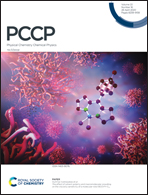O–H vibrational motions promote sub-50 fs nonadiabatic dynamics in 3-hydroxypyran-4-one: interplay between internal conversion and ESIPT†
Abstract
A theoretical study is used to explore the involvement of O–H vibrational motions in the S0 → S2 photoinduced dynamics of 3-hydroxypyran-4-one (3-HOX). Two transitions, S0 → S1 and S0 → S2, are attributed to the experimentally observed electronic absorption spectral features in the range of 3.5–5.5 eV. We compute model potential energy surfaces of vibronically coupled S1 (nπ*) and S2 (ππ*) states with the aid of extensive electronic structure calculations. The S1–S2 conical intersection is characterized in the O–H bend and O–H stretch vibrational coordinate space. Quantum wavepacket dynamics simulations reveal an ultrafast S2 → S1 internal conversion decay, where about 90% of the S2 population disappears within the first 50 fs of the propagation time. The participation of O–H vibrational motions in the early events of nonadiabatic dynamics is analyzed based on the time evolution of nuclear densities on S2. We discuss the implications of these observations to provide fundamental insights into the nonadiabatic excited-state intramolecular proton transfer in 3-HOX and its derivatives.



 Please wait while we load your content...
Please wait while we load your content...